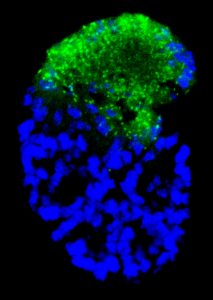
Segmentation in tardigrades
Tardigrades are segmented animals, but their segmented body plans develop much differently than do the segmented body plans of their closest relatives, the arthropods and onychophorans. Elucidating how segments develop in tardigrades may provide insight into the origin and diversification of segmented body plans in Panarthropoda (Tardigrada, Arthropoda, Onychophora). We are especially interested in uncovering how tardigrades lost mid-trunk segments, an ancient event that contributed to the evolution of the highly compact body plan of modern tardigrades.
Gut development in tardigrades
The evolution of an anatomically regionalized through-gut was key to the success of bilaterian animals. Highly conserved developmental mechanisms pattern the regionalized through-gut of bilaterian animals. Unlike many other animals, the tardigrade body plan is highly reduced, lacking several organ systems and
body regions that are found in other animals. The secondarily simplified body plan of tardigrades evolved

in association with the evolution of miniaturized body size. We are particularly interested in uncovering the consequences of miniaturization on the the evolution of through-gut anatomy and the mechanisms that pattern the through-gut in tardigrades.
Leg development in tardigrades
There is an incredible diversity of appendage types in Panarthropoda, from legs, to antennae, to mouthparts, to swimming appendages, and appendages may be jointed or unjointed depending on the lineage in question. Amazingly, a very similar suite of genes patterns this incredible diversity of appendages in the arthropods and onychophorans that have been investigated. We are studying developmental patterning of legs in tardigrades to elucidate how appendages developed ancestrally in Panarthropoda, and how these developmental mechanisms evolved to produce the amazing diversity of appendage types seen in extant members of this lineage.

Protocol establishment for studies of Hypsibius exemplaris development
Frank Smith previously established a colorimetric in situ hybridization technique for the tardigrade H. exemplaris. In the Smith Lab, we aim to continue to establish methods for studying develop of H. exemplaris embryos. Recently, we have established a method that allows us to visualize the expression of two genes simultaneously using tyramide signal amplification. We aim to establish new methods to study gene expression and function in H. exemplaris embryos.
